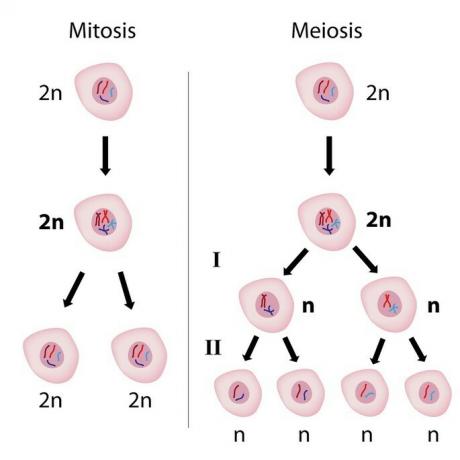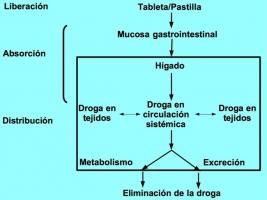Difference between mitosis and meiosis
Mitosis and meiosis are two different forms of cell division in eukaryotic cells, those that have a nucleus.
During the cell cycle, the eukaryotic cell undergoes a series of changes that lead to the formation of new cells. Depending on the type of cell, it can divide by mitosis or meiosis.
For example, in organisms that reproduce sexually, germ cells divide by meiosis to give rise to sex cells or gametes. Somatic cells, on the other hand, only divide through mitosis.
| Mitosis | Meiosis | |
|---|---|---|
| Definition | Nuclear division process in which two nuclei are generated with the same number of chromosomes from the cell of origin. | Nuclear division process that originates four cells with half the number of chromosomes of the cell of origin. |
| Stages or phases |
|
Meiosis I:
Meiosis II:
|
| Number of nuclear divisions | 1 | 2 |
| Number of genetic duplications | 1 | 1 |
| Chromosome crossover and recombination | Absent. | Present in prophase I and metaphase I. |
| Outcome | Two daughter cells with the same amount of genetic material. | Four cells with half the genetic material. |
| Example | Cells in the dermis proliferate to renew skin cells. | Germ cells located in the gonads produce the gametes. |
Mitosis
Mitosis is a process of cell division that occurs in the nucleus of eukaryotic cells, after the duplication of genetic material at the interface. This process is present in both unicellular and multicellular beings. It is also known as karyokinesis.
In mitosis, one diploid cell gives rise to two diploid cells with the same genetic information.
Phases of mitosis
Mitosis is a continuous process where four successive phases can be identified:
- Prophase: genetic material begins to condense and form long, thin strands. The mitotic spindle is formed.
- Metaphase: disappearance of the nuclear envelope or karyotheque and location of the chromosomes in the cell equator.
- Anaphase: chromosomes migrate to the poles of the cell.
- Telophase: At each pole of the cell, the nuclear envelope begins to reorganize itself, surrounding the chromosomes that are already breaking down.
Mitosis is followed by the process of cytokinesis or cytodieresis, that is, the division of the cytoplasm to give rise to two daughter cells.
In this video you can see the formation of the mitotic spindle, which is that starfish-like structure with a yellow center and red tentacles. The chromosomes look like plump worms, which are being dragged by the spindles to opposite ends of the cell.
Animation of the mitosis process showing the prophase, metaphase, anaphase and telophase stages.
Importance of mitosis
Mitosis occurs in undifferentiated somatic cells and stem cells. Its importance lies in the fact that it is essential for the following cellular processes:
- Developing: from the zygote, which is the first cell of a multicellular individual, the millions of different cells that constitute a higher organism are generated.
- Increase: allows an increase in the number of cells in organisms, promoting their growth.
- Tissue repair and renewal: Through mitosis, new cells are regenerated to replace cells that die or are lost.
Meiosis
Meiosis is the process of cell division of a diploid cell (2n) to give rise to four haploid cells (1n). The result is the gametes or sex cells: sperm in the male and ovules in the female of most species.
The general process of meiosis involves two successive nuclear divisions, with no duplication of genetic material in the intermediate step. Furthermore, crossover and chromosomal recombination occurs, so the resulting four cells do not necessarily carry the same genetic information.
Phases of meiosis
Since meiosis occurs after two nuclear divisions, known as meiosis I and meiosis II, the phases are given the same name as the stages of mitosis followed by the number of the period in which occur:
Meiosis I
- Prophase IHomologous chromosomes pair up and exchange genetic material by crossing over.
- Metaphase I: Chromosomes are located at the equator of the cell in a random way.
- Anaphase I: Homologous chromosomes separate and go to the poles of the cell.
- Telophase I: The chromosomes that are already at the poles begin to be disorganized and to be surrounded by the nuclear envelope.
When this first period of cell division ends, two diploid cells are obtained with the same amount of genetic material.
Meiosis II
Daughter cells of period I enter a short interface II, where the chromosomes are disorganized and there is no genetic duplication.
- Prophase II: The chromatin condenses again and the nuclear envelope disappears.
- Metaphase II: The chromosomes formed by two chromatids are located at the equator of the cell.
- Anaphase II: sister chromatids separate and are brought to the poles of the cell.
- Telophase II: Chromosomes now with a single chromatid are found at the poles and the nuclear envelope around them begins to reorganize.
At the end of this second period of nuclear division, the result is four haploid cells, each containing half of the genetic material.
Importance of meiosis
Meiosis occurs only in the cells that will give rise to the gametes, or germ cells. Thanks to this process, from a cell with a chromosomal load equal to 2n, four cells with a chromosomal load 1n are generated.
In meiosis, genetic recombination of homologous chromosomes occurs, which increases genetic variability in species.
Gametogenesis is the process of formation of gametes or sex cells, which have half of the 1n chromosomal load (haploid). When two gametes, one male and one female, fuse, a 2n diploid cell is formed, that is, with the complete genetic makeup of the species.
Comparison of the process of mitosis and meiosis

We could compare the processes of mitosis and meiosis in the following way: the mitosis of a cell is like a photocopy of a page of a book, with the final result of two pages with the same contents. Whereas cell meiosis is a page from a book that we have photocopied and then divided in two, resulting in four pieces of paper with partially different content.
Learn more about:
- Diploid and haploid cells
- Eukaryotic cell and prokaryotic cell
- Animal and plant cell

Doctor in Biochemistry from the Venezuelan Institute of Scientific Research (IVIC), with a degree in Bioanalysis from the Central University of Venezuela.



